Monday, 13 May, 2019. 11:41
We are sitting in the Confeitaria Nacional, a traditional and old pastry shop in the old town Baixa area of Lisbon. A review site I looked at this morning said this has some of the best custard tarts in town, so of course we had to try them. We’re sitting in for a short break from the heat outside, although it hasn’t really gotten as hot as yesterday yet, and we’ve been waling among the shady narrow streets of the old area.
We slept pretty well, rousing drowsily about 06:00. We got up slowly and prepared for breakfast in the hotel restaurant, arriving there shortly after it opened at 07:00. It wasn’t very busy yet. There was a good spread of food and we had muesli with yoghurt, some small croissants, bread and cheese, and fresh fruit. They also had bowls of ingredients which you could put together and hand to the waiter to have the chef make a custom plate of eggs with, but we didn’t try this.
After eating, we returned to our room to get ready for the day out. With the forecast being 33° and sunny, we used sunscreen and wore long sleeve shirts to keep the sun off, even though it will be hot.
 Monkey riding the Metro |
We left and got on the Metro at Entrecampos, right outside our hotel. I though this would take us direct to Terreiro do Paço station by the waterside, but we realised we had to change lines at Marquês de Pombal. The first train was full and crowded, but the second one was empty enough for us to get seats. We got off at Terreiro do Paço and negotiated the exits, having to turn around when we ended up in a wharf area with departing ferries, and no easy way to get to where we actually wanted to go.
After leaving by another exit, we emerged near the square leading down to Cais dos Colunas, a set of limestone steps descending into the river, which seems to be a historical place where Portuguese ships of exploration embarked from. (Doing some research later I discovered that these steps used to lead from the river directly up to the royal palace. However the palace was destroyed in the 1755 earthquake and never rebuilt, so now the stairs lead up to an open plaza.)
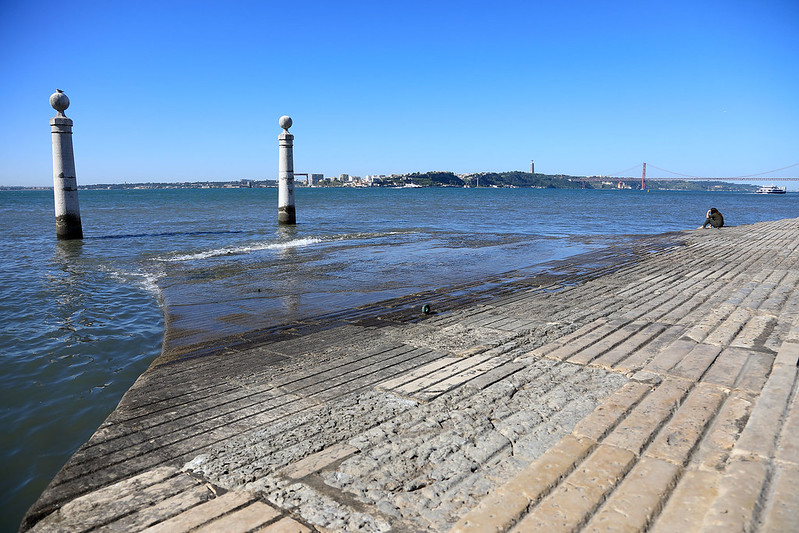 Cais dos Colunas |
There were some tourists around early but it wasn’t crowded. We walked from there into Praça do Comércio, the large open square behind it, with a large statue in the middle, behind which was a huge limestone arch (the Arco da Rua Augusta) leading to a promenade behind it, through the heart of Lisbon, the Baixa area.
 Praça do Comércio and the Arco da Rua Augusta |
We went through the arch into the grid of narrow streets, some carrying traffic but many pedestrianised, with 4 and 5 storey buildings on each block populated by shops at street level and apartments above. This area was largely destroyed in the 1755 earthquake, and fully rebuilt on a planned grid of streets. So all of the buildings here are 18th century, and somewhat resemble the buildings of similar vintage in Paris.
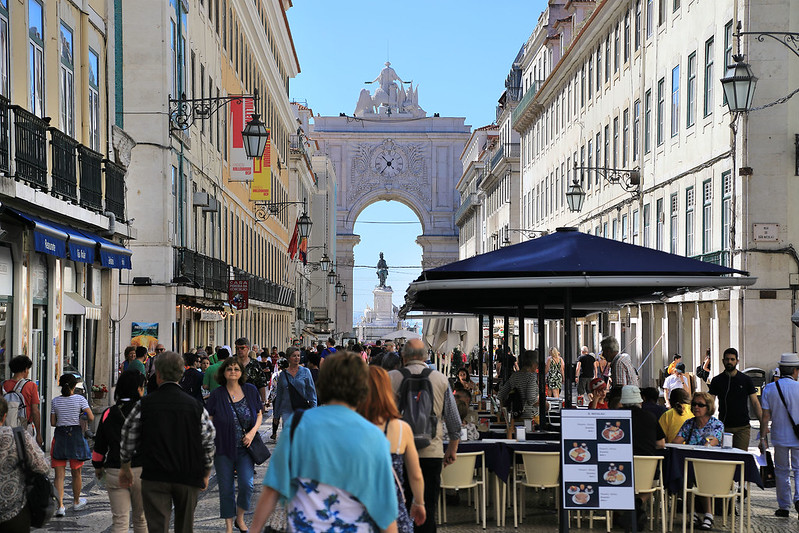 Rua Augusta, Baixa |
The footpaths and pedestrian zones in Lisbon are all paved with cobblestones, a mixture of mainly white limestone with black basalt used to produce intricate patterns. We saw this yesterday along the walking paths we took, but now it became clear that this paving is everywhere. Another thing they have in Lisbon is lots of jacaranda trees, and at this time of year (very late spring) they were in bloom, with purple flowers visible all over the city. It reminded me of back home in Sydney, where the jacarandas bloom in November. I was surprised to see jacarandas in a European city, until I realised that Portugal colonised Brazil, where jacarandas are native, and must have brought the trees back with them.
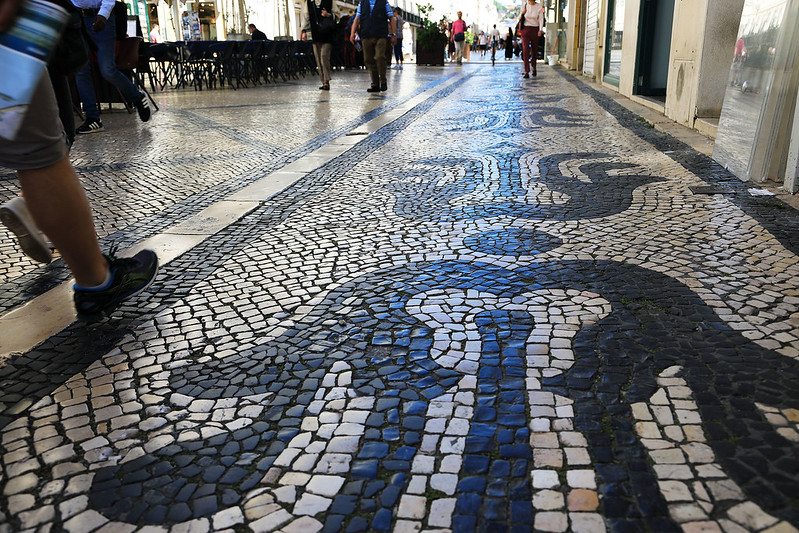 Portuguese paving |
We meandered around at random, turning this way and that whenever we saw something interesting, slowly working our way north. At one point I spied a good looking pasteleria, Nata de Lisboa, and went in to buy one of the famous pastéis de nata, or custard tarts, for 1€ (it was 1.50€ if you sat at a table). It was warm and good and sweet and the pastry was crisp and flaky, and it was all delicious.
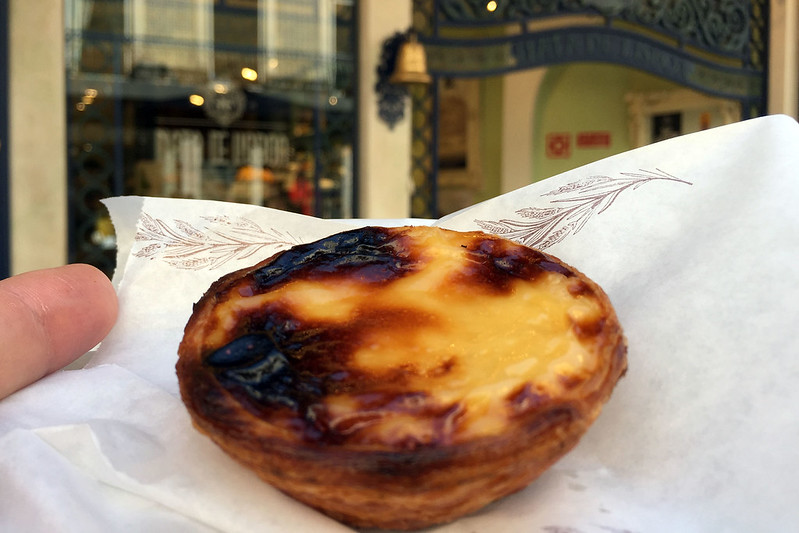 Pastel de nata from Nata de Lisboa |
Now here at the Confeiteria Nacional, the tarts had cooled down and the custard was firmer, but otherwise quite similar. I prefer it still warm and gooey, but the cool ones were very good too. M. has had a cappuccino, which came with cinnamon sprinkled on top, and she said it was very strong.
 Pastel de nata from Confeiteria Nacional |
15:39
We’re having another rest out of the afternoon heat, at Cantinho de Sé, a small pasteleria cafe near the Lisbon Cathedral. We came here via a rather roundabout route, around the hill on which the old Lisbon Castle of São Jorge sits. We left the Confeiteria Nacional and headed east, attempting to tackle the hill from the north side. We found a series of escalators running up beside stairs up part of the hill and took those, gaining a bit of elevation that way, and then tried to continue our way uphill, heading into Lisbon’s Mouraria neighbourhood.
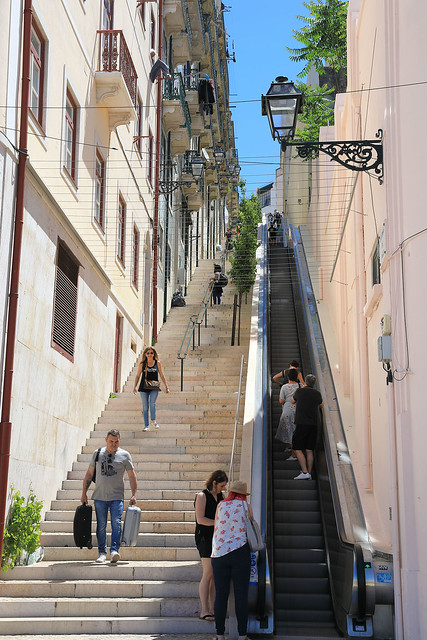 Escalators leading up the hill to the castle |
At one point M. suggested following a side street that looked interesting and we found ourselves in a nice little neighbourhood with narrow streets, small squares, and interesting little restaurants. It was after midday now and we decided to stop for lunch. We found a few places that would work: an Italian place with pastas and pizzas, a more traditional looking Portuguese place with meat dishes, but also grilled salmon which M. could have tried if she felt like it.
 Street in the Mouraria neighbourhood |
But we decided on a place that made freshly baked empanadas with six different savoury fillings, as well as a couple of sweet ones. It was called Union Empanadas, and they had corn, cheese & onion, spinach & onion, tuna, chicken, and veal empanadas, plus sweet potato and dulce de leche ones for desserts. We ordered one of each savoury type except the corn. The lady serving us also suggested fresh ginger juice that they made daily, so I got one of those. And she asked if we wanted mild or spicy sauce for our empanadas. M. got mild and I got spicy. The empanadas came served two to a small wooden paddle, and the sauces were in small steel bowls, looking like chopped herbs and chillis in oil. The empanadas were delicious and hot, the fillings nicely spiced even before adding the sauces. The spicy one was a bit hot but not dangerous. The ginger juice was very nice, not too sharp and not too sweet. The menu was painted on the wall in a fancy lettering style, and the lady told us that the artist was Gonçalo Jordão, who had painted the sets as part of the Oscar-winning production design team for the film The Grand Budapest Hotel.
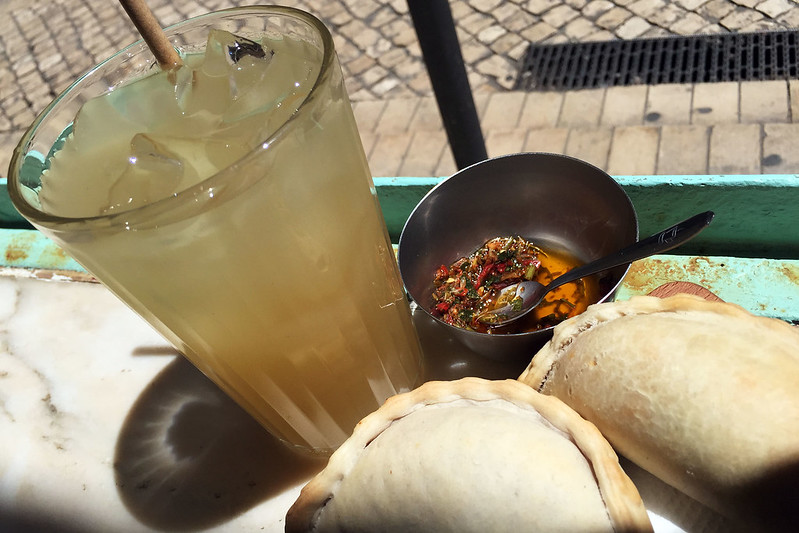 Lunch at Union Empanadas |
We sat for a while at the open window, looking out at the narrow street outside and the people walking past the colourful walls and doors and windows. A huge rubber tree, four or five metres tall, was growing against the wall, its trunk rising from a tiny pot not much bigger than a standard mop bucket. Before we left we used the toilet there, which was in an incredibly tiny room, basically the size of an aeroplane toilet.
Returning to our quest to get to the castle, we took another set of stairs up the hill, then turned around a few switchback streets. We walked along a street circling the top of the hill clockwise, and I thought my map showed another set of stairs on the right leading up to the castle. But we walked suspiciously far without finding them, and just as I was looking at the map on my phone a guy near us, who was walking the same way with a woman, asked me if we knew the way to the castle. I said we were trying to find it too. He said he was using the CityMaps Go app, and I said so was I, and then he said the same thing about thinking there should have been a set of stairs around here somewhere. We both zoomed in to the map on our phones and saw that the dashed line representing a pedestrian path actually ended a bit before the street we were on, and so was probably just a path inside the castle to the tower on the hill above us. We both concluded we had to keep walking around to the next intersection.
 Exploring Mouraria |
It turned out that the street led us a long way around the hill. The next intersection had an entrance to the castle, but it was for authorised vehicles only, and a sign there said that the public entrance to the castle was further along. We even ended up walking back downhill again for a while before finding a turn that took us up the hill towards the entrance. After climbing the hill we hit a street full of tourists and knew we were on the right track. Further up was a small square with a lot of tourists sitting in the shade and a bunch of vendors selling various drinks, ice creams, and trinkets. There was even a red British phone box!
M. waited in the shade while I queued up to enter the ticket office. It cost 10€ each for tickets to enter Castelo São Jorge. We scanned the tickets at the entrance turnstiles and went in to the castle grounds. First stop was a paved courtyard with grand views over the city. Thankfully there were a lot of trees and much of the area was shaded. Old cannons dating from around 1820 according to the engraving on the bronze barrels studded the castellated wall.
 View over Lisbon from Castelo São Jorge |
After doing a circuit of the courtyard we ended up at a gift shop, which we dawdled in for a while to enjoy the cool air conditioning. Nearby was a very fancy looking restaurant with three small stone lions out the front. It had “Leonhas” or something in its name, alluding to the lions no doubt.
We walked through another courtyard area where people were variously sitting at cafe tables, gawking at a couple of peafowl which were wandering around, or taking photos of the rather plump backside of a crouching stone statue of a naked woman on a plinth at eye level. From here we entered the castle keep area, with its tall limestone walls topped with crenellations. Inside we climbed some steps to the ramparts, and an intermediate level, seeing the deep arrow slits set into the walls.
 Entering the keep of Castelo São Jorge |
21:19
The limestone steps of the castle were smooth and a bit slippery, so we took care climbing the steps and walking along the ramparts, as the railings were very low and would have been easy to tumble over. We managed to stay incident free as we got wonderful views over Lisbon, but didn’t dawdle as there was little shade on the top levels. The keep courtyard had what looked like a wooden stable roof in one part, but otherwise no evidence of any living quarters, so we presumed that there must have been wooden buildings inside the walls at some point.
 View from battlements of Castelo São Jorge |
Leaving the castle we walked down the hill the short way back towards the old town, continuing clockwise around the hill rather than the long way back the way we’d come. We headed towards the Lisbon Cathedral, stopping at a cafe just before getting there for a rest out of the sun and some drinks. M. got an iced coffee while I had a lot of water.
 Lisbon Cathedral |
After that we continued into the cathedral, staying cool inside its thick stone walls. It was built in the 12th century and had heavy limestone construction, with thick walls and small windows, and a roof supported by many thick stone columns. It was massive and heavy, not spacious and light like later styles when builders mastered the art of making such large buildings feel thinner and more airy. The only stained glass was in three rose windows, one above the main entrance and one in each transept wing, plus a couple of fairly small portraits of Saints Vincent and Antonio in the right transept. A tour group wearing red scarves was being escorted around the interior and there were a few other tourists but it wasn’t crowded.
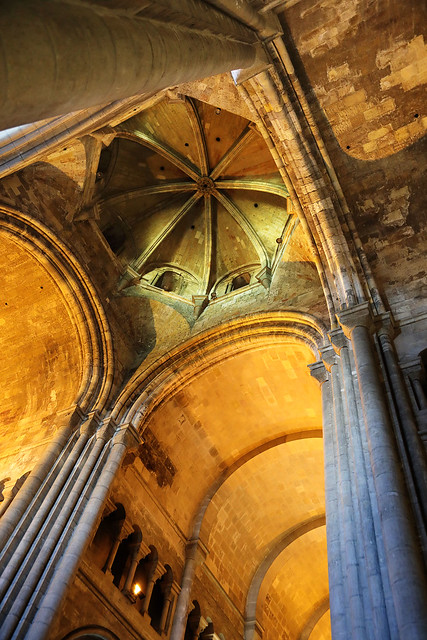 Inside Lisbon Cathedral |
Leaving the cathedral we decided to head not west back to the old town, but east to the Alfama neighbourhood, to check out what looked like a maze of narrow pedestrian streets on the map. This turned out to be a good decision as the area was interesting and picturesque, running up and down the hillside with many sets of stairs connecting roads running across the slope. Scattered amongst the residences were numerous small restaurants, cafes, and artist shops. We wandered this area for a while, then used my map app to find a suitable place for dinner, locating a wine and tapas bar called A Muralha Tapas e Vinhos. We walked a roundabout route to get us there just before 18:00.
When we arrived we found the place to be a dim den with only a few tables. The waitress pulled apart a table for four occupied by two other people and gave us the free half. I sat on a small square wooden stool while M. sat on the wooden bench seat against the wall. The menu didn’t have a lot of variety that we expected from a place calling itself a tapas bar. Most of the dishes were various cheese and/or charcuterie plates, with a couple of salads to round things out. We chose the cheese sample platter, which had about a dozen different types of cheese on it, in small portions, with quince paste, olives, and a jam that may have been sweet orange or mandarin. We also got some bread to go with it, as the cheese platter only came with a very few tiny crackers, nowhere near enough for the large amount of cheese.
 Cheese and wine at A Muralha |
When it arrived, it was impressive. There was a ball shaped cheese with the top sliced off and a spoon put in, which was used to scoop up the almost liquid runny cheese inside the rind. There was a blob of a cream cheese with some herbs, and there were slices of ten or so other different types. With this we ordered a glass each of a Vinho Verde wine from Portugal. This was crisp and pleasant, with a lemon-lime tartness to it, that set off the cheeses nicely. We planned to get more dishes and wine later, but the cheese was very filling so we settled for a mixed salad, of leaves, cherry tomatoes, and olives, with glasses of water. After this I had a glass of a Madeira wine, which was a pale red, slightly sweet, but with a lasting complexity like a good red wine. It was nice, and quite strong.
 Monkey with a glass of madeira |
As we ate, a group of ten or so American tourists came in, with a local guide who lectured them on Portuguese food and wine as they sampled various dishes. It was interesting listening in. After we’d finished, we paid and walked over to the nearest Metro station at Santa Apolónia Station. There we caught the train back to our hotel and turned in for the night after cleansing and refreshing showers.
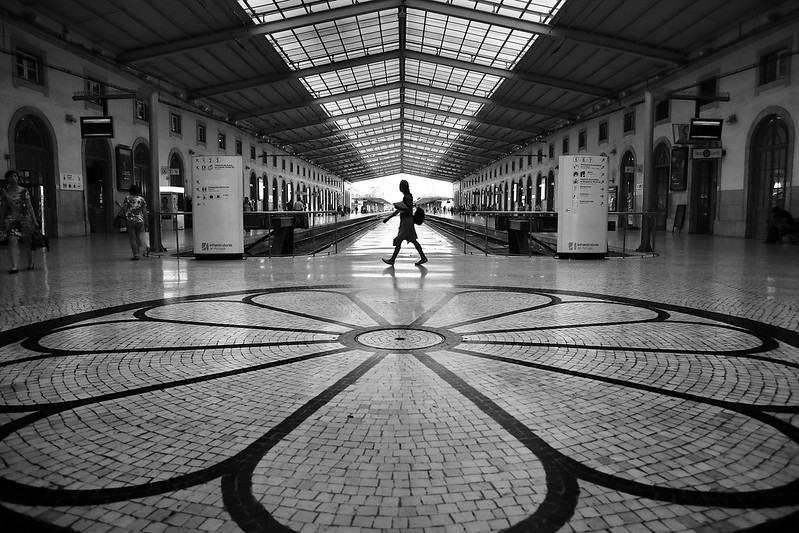 Santa Apolónia Station |
